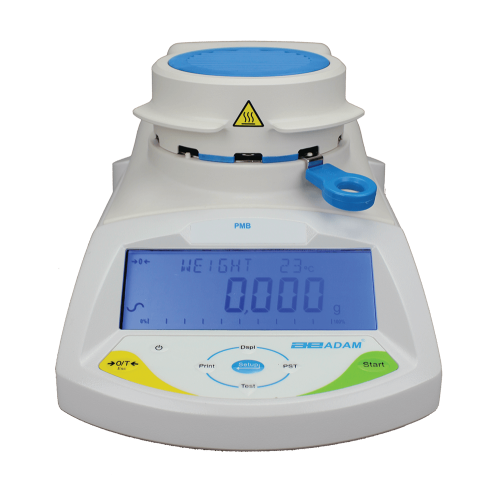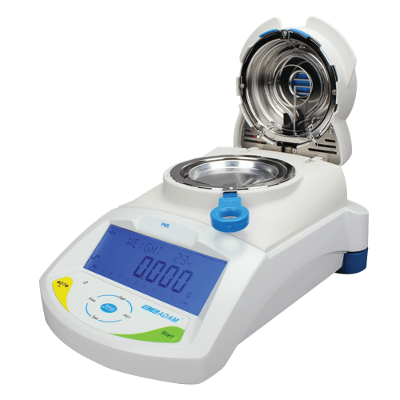Loading... 8 view(s)
Moisture analysers (also known as moisture balances) are used to check the moisture content of a sample. They are widely used in the food industry and can provide critical information about food quality. In moisture analysis, samples are often processed before they’re heated in order to dry evenly, help prevent burns and get correct measurements. Proper sample preparation ensures consistent results, can reduce the chance of errors and ensures the reliability of the tests. Here are some common steps that should be carefully replicated during sample preparation.
While basic mass measurements do not require as much preparation (since the samples aren’t heated), these guidelines can also be useful when weighing samples on analytical or semi-micro balances, since they’re very sensitive instruments.

 The PMB moisture analyser allows users to create custom test settings to dry samples as efficiently as possible. The three different heating modes help ensure samples are dried quickly, evenly and not damaged when heated. The PMB features a memory that can save up to 49 recipes and 99 test results for convenient recall of frequently used testing procedures.
Read more about getting started with a moisture balance here.
To check out our range of Adam Equipment moisture analysers, click here. If you have any questions, feel free to contact us at support@camlab.co.uk
Thank you to the team at Adam Equipment for providing this guest article, which we have adapted. It was originally published here.
The PMB moisture analyser allows users to create custom test settings to dry samples as efficiently as possible. The three different heating modes help ensure samples are dried quickly, evenly and not damaged when heated. The PMB features a memory that can save up to 49 recipes and 99 test results for convenient recall of frequently used testing procedures.
Read more about getting started with a moisture balance here.
To check out our range of Adam Equipment moisture analysers, click here. If you have any questions, feel free to contact us at support@camlab.co.uk
Thank you to the team at Adam Equipment for providing this guest article, which we have adapted. It was originally published here.

Steps to follow:
- Before measuring samples, make sure they’re stored in airtight containers in a room with controlled temperature. Some samples are volatile or change when exposed to humidity, cold, light, heat or other factors.
- Make sure that containers and tools you’ll be using are all clean.
- Tare the container you will be using to hold the sample, including glass fiber pads.
- Measure the sample size that you need to analyse. Some industries require that a sample weighs a certain amount for testing (for example, a type of cheese could be required to be tested 3 times with chunks of 25g for standardised testing).
- Record the weight.
- Process the sample as needed. Some samples need to be ground into powders or paste in order to be properly analysed. Make sure that the samples are not heated or cooled during the process, and avoid contamination by using clean, smooth tools. The powder or paste must be fine with even consistency. If liquid, the samples must be mixed evenly and without bubbles.
- Distribute the sample thinly and evenly on the sample pan (if solid) or spread on the glass fiber pad (if liquid or a paste). Doing so ensures a consistent drying process and helps avoid burns and uneven heating. Uneven samples can splatter during heating, while even samples dry more quickly. Use a spatula for solids and pastes, or a pipette for liquid. Do not handle the sample without tools to avoid contamination.
- Follow drying and heating procedures for the material being tested in order to ensure the tests do not damage the samples, and that drying is conducted efficiently.
 The PMB moisture analyser allows users to create custom test settings to dry samples as efficiently as possible. The three different heating modes help ensure samples are dried quickly, evenly and not damaged when heated. The PMB features a memory that can save up to 49 recipes and 99 test results for convenient recall of frequently used testing procedures.
Read more about getting started with a moisture balance here.
To check out our range of Adam Equipment moisture analysers, click here. If you have any questions, feel free to contact us at support@camlab.co.uk
Thank you to the team at Adam Equipment for providing this guest article, which we have adapted. It was originally published here.
The PMB moisture analyser allows users to create custom test settings to dry samples as efficiently as possible. The three different heating modes help ensure samples are dried quickly, evenly and not damaged when heated. The PMB features a memory that can save up to 49 recipes and 99 test results for convenient recall of frequently used testing procedures.
Read more about getting started with a moisture balance here.
To check out our range of Adam Equipment moisture analysers, click here. If you have any questions, feel free to contact us at support@camlab.co.uk
Thank you to the team at Adam Equipment for providing this guest article, which we have adapted. It was originally published here.






